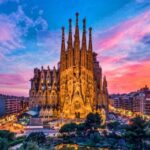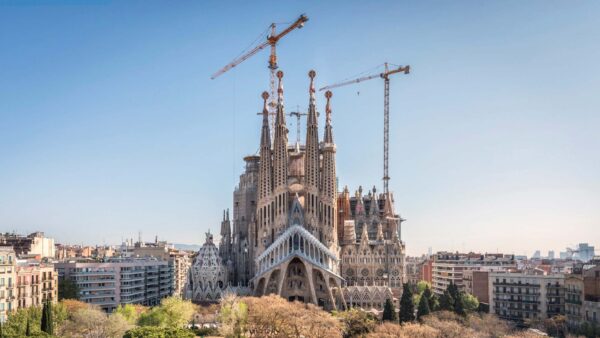
In the heart of Barcelona stands a masterpiece that has captivated generations: the Sagrada Familia. This iconic basilica, designed by the visionary architect Antoni Gaudí, embodies the city's rich cultural heritage and artistic ambition.
As we explore The Saga of Sagrada Familia: Barcelona's Timeless Construction, we delve into the intricate history and the ongoing journey of this architectural wonder, which has become a symbol of perseverance and creativity in the face of time.
The Architectural Marvel of Sagrada Familia: A Masterpiece in Progress
The Sagrada Familia is not merely a church; it is an architectural marvel that reflects the unique vision of its creator, Antoni Gaudí. The basilica's design intricately blends Gothic and Art Nouveau styles, evident in its soaring towers and intricate facades. Each element serves a symbolic purpose, contributing to the spiritual narrative woven throughout the structure.
Currently, the construction of the Sagrada Familia continues to be a monumental endeavor, attracting millions of visitors each year. The ongoing work showcases innovative techniques and a commitment to preserving Gaudí's original vision, highlighting the fusion of traditional craftsmanship with modern technology. This combination has resulted in a project that remains dynamic and evolving.
- Height: The basilica will eventually reach a height of 172.5 meters, making it the tallest religious building in Europe.
- Completion Date: It is anticipated that the Sagrada Familia will be completed by 2026, coinciding with the centenary of Gaudí's death.
- Visitor Impact: Over 4.5 million people visit the site annually, affirming its significance as a cultural landmark.
In summary, the Sagrada Familia stands as a testament to human creativity and determination. This masterpiece in progress not only showcases the architectural brilliance of Gaudí but also embodies the spirit of Barcelona itself—a city that embraces both its past and its future. The ongoing construction serves as a reminder that true artistry transcends time, continually evolving while remaining rooted in its origins.
Exploring the History of Sagrada Familia: From Vision to Reality
The history of the Sagrada Familia is a testament to the vision of Antoni Gaudí, who began this monumental project in 1882. Initially conceived as a traditional Gothic basilica, Gaudí transformed the design into a unique blend of organic forms and innovative structures, inspired by nature and his deep religious faith. This transformation laid the foundation for what would become one of the most iconic landmarks in the world.
Throughout its construction, the Sagrada Familia has faced numerous challenges, including financial constraints and the interruption of work during the Spanish Civil War. Despite these setbacks, the project has continued to evolve. Today, a team of architects and artisans are dedicated to bringing Gaudí's vision to life, ensuring that each detail remains true to the original plans. This collaborative effort highlights the importance of preservation in maintaining the integrity of the basilica.
- Original Vision: Gaudí's intention was to create a structure that would be a “Bible in stone,” telling the story of Christianity through its architectural elements.
- Construction Milestones: Key milestones in the construction include the completion of the Nativity facade in 1935 and the ongoing work on the Glory facade.
- Current Techniques: Modern technology, including 3D modeling, is employed to ensure accuracy and efficiency in completing the intricate designs.
As we explore the history of the Sagrada Familia, it becomes clear that its construction is not just an architectural endeavor, but a cultural and spiritual journey. This ongoing project invites visitors to witness the melding of art and faith, creating a dynamic narrative that continues to unfold. With each passing year, the Sagrada Familia stands not only as a symbol of Barcelona but also as a living testament to human perseverance and creativity.
Gaudí's Ingenious Designs: The Artistic Influence on Sagrada Familia
Gaudí's ingenious designs for the Sagrada Familia are a harmonious blend of natural forms and religious symbolism. Drawing inspiration from the organic shapes found in nature, he incorporated elements such as tree-like columns and intricate facades that mimic the flora of Catalonia. This unique approach not only enhances the aesthetic appeal but also invites visitors to experience a deeper spiritual connection within the basilica.
Some key features of Gaudí's artistic influence include:
- Hyperboloid Structures: These shapes contribute to the basilica's strength and elegance, allowing for larger spaces and enhanced acoustics.
- Colorful Stained Glass: The use of vibrant colors creates a dynamic interplay of light within the interior, symbolizing divine presence and transformation.
- Natural Lighting: Designed to mimic the effects of daylight in nature, the placement of windows and skylights allows for a constantly changing atmosphere throughout the day.
The facades of the Sagrada Familia are a testament to Gaudí's artistic vision, each narrating a different aspect of the life of Christ. The Nativity Facade, for instance, showcases the beauty of creation through detailed sculptures, while the Passion Facade reflects themes of suffering and redemption. This intricate storytelling through architecture not only communicates religious themes but also invites introspection among its viewers.
In summary, Gaudí's contribution to the Sagrada Familia transcends traditional architectural boundaries. His innovative designs and artistic influences have transformed this basilica into a living canvas, where every detail serves a purpose, merging art with spirituality. The ongoing construction stands as a tribute to his genius, as well as a commitment to preserving the essence of his timeless vision.
The Future of Sagrada Familia: Completion Timeline and Expectations
The future of the Sagrada Familia is approaching a significant milestone, with expectations set for its completion in 2026. This date is particularly symbolic, as it coincides with the centenary of Antoni Gaudí's passing, marking 100 years since the visionary architect's untimely death. This timeline embodies the ongoing dedication to honoring his legacy while bringing his grand vision to fruition.
As the project moves closer to completion, key elements are being prioritized. The focus includes:
- Completion of the Towers: The basilica will feature 18 towers, each representing a different figure in Christianity, culminating in a central tower dedicated to Jesus Christ.
- Interior Finishing: Craftsmanship in the interior continues to evolve, with artisans meticulously working on the intricate details that define Gaudí's original design.
- Sustainability Practices: Modern construction methods aim to enhance efficiency while preserving the environmental integrity of the site.
The completion of the Sagrada Familia is expected to not only fulfill Gaudí's original vision but also to enhance its role as a cultural beacon for visitors worldwide. Anticipated to draw even more than the current 4.5 million visitors annually, the finished basilica will serve as a vibrant space for both worship and tourism, uniting faith and artistry in a new era.
Overall, the future of the Sagrada Familia is not merely about the physical structure but also about the ongoing dialogue between history, culture, and spirituality. As it stands today, this masterpiece remains a testament to human ingenuity and artistic ambition, promising to inspire generations to come.
Cultural Significance of Sagrada Familia: A Symbol of Barcelona's Heritage
The Sagrada Familia holds profound cultural significance as a symbol of Barcelona's heritage, serving as a beacon of artistic expression and religious devotion. Its unique architectural style, combining Gothic and Art Nouveau elements, reflects the city's historical evolution and Gaudí's innovative spirit. This basilica not only attracts millions of tourists annually but also inspires a deep sense of pride among locals, underscoring its role as an essential part of Barcelona's identity.
As a living testament to the city’s artistic legacy, the Sagrada Familia encapsulates the essence of Catalonian culture. It embodies a fusion of religious symbolism and artistic ambition, inviting visitors to engage with the narratives woven into its facades. Through its ongoing construction, the basilica showcases a dedication to preserving traditional craftsmanship while embracing contemporary techniques, reinforcing its status as a cultural landmark that evolves with time.
The Sagrada Familia serves as a gathering place for both worship and reflection, bridging the gap between faith and community. Its intricate designs and symbolic elements resonate with people from diverse backgrounds, fostering a sense of unity and shared history. As the basilica approaches its completion, its significance will only deepen, further solidifying its role as a cornerstone of Barcelona's cultural heritage.
In the broader context of European architecture, the Sagrada Familia stands out as a symbol of innovation and resilience. As it continues to inspire architects and artists around the world, it challenges conventional boundaries, demonstrating that true creativity can transcend time and space. This ongoing journey of construction is not merely about finishing a building; it is about honoring a vision that will leave an indelible mark on future generations.
Visiting Sagrada Familia: Tips for an Unforgettable Experience
When planning your visit to the Sagrada Familia, it is essential to book your tickets online in advance. This not only helps you avoid long queues but also allows you to choose the best time for your visit. Consider visiting during off-peak hours, such as early in the morning or late in the afternoon, to enjoy a quieter experience. Remember that the basilica is still under construction, so be prepared for some areas to be restricted or under renovation.
To make the most of your visit, consider taking a guided tour. A knowledgeable guide can provide invaluable insights into the architectural details and the rich history behind the Sagrada Familia. Audio guides are also available for those who prefer exploring at their own pace while still gaining an understanding of Gaudí's vision. Here are some tips to enhance your experience:
- Plan Your Route: Familiarize yourself with the layout of the basilica and identify key areas you want to explore.
- Bring a Camera: The stunning facades and intricate interiors offer countless photo opportunities.
- Dress Respectfully: As a place of worship, adhere to a dress code that respects the sanctity of the site.
Don't forget to spend time in the surrounding park, where you can appreciate the Sagrada Familia's beauty from different angles. The park provides a perfect backdrop for photos and moments of reflection. Additionally, exploring local eateries nearby can give you a taste of Catalonian cuisine, making your visit to this architectural gem not just a feast for the eyes, but for the palate as well.
 Traveling from Sagrada Familia to Barcelona Airport: Your Complete Guide
Traveling from Sagrada Familia to Barcelona Airport: Your Complete Guide The Undeniable Beauty of Barcelona's Sagrada Familia: Exploring the 11th Wonder
The Undeniable Beauty of Barcelona's Sagrada Familia: Exploring the 11th WonderIf you want to know other articles similar to The Saga of Sagrada Familia: Barcelona's Timeless Construction you can visit the category WHERE YOU CAN GO.
Leave a Reply










Read more!